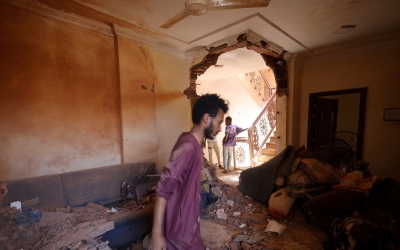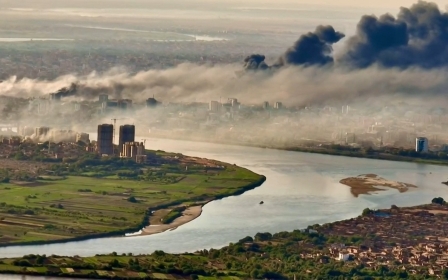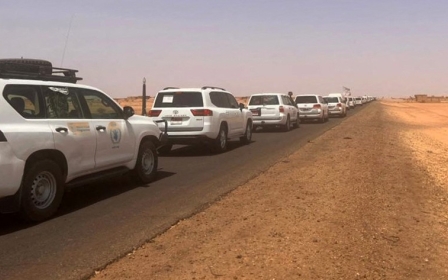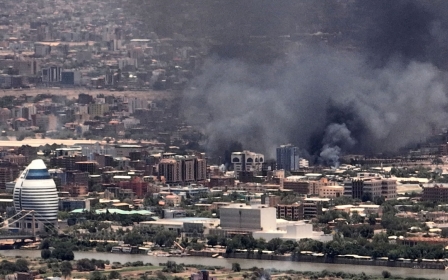Sudan crisis: Syrians and Yemenis stuck in Port Sudan as they seek escape from war
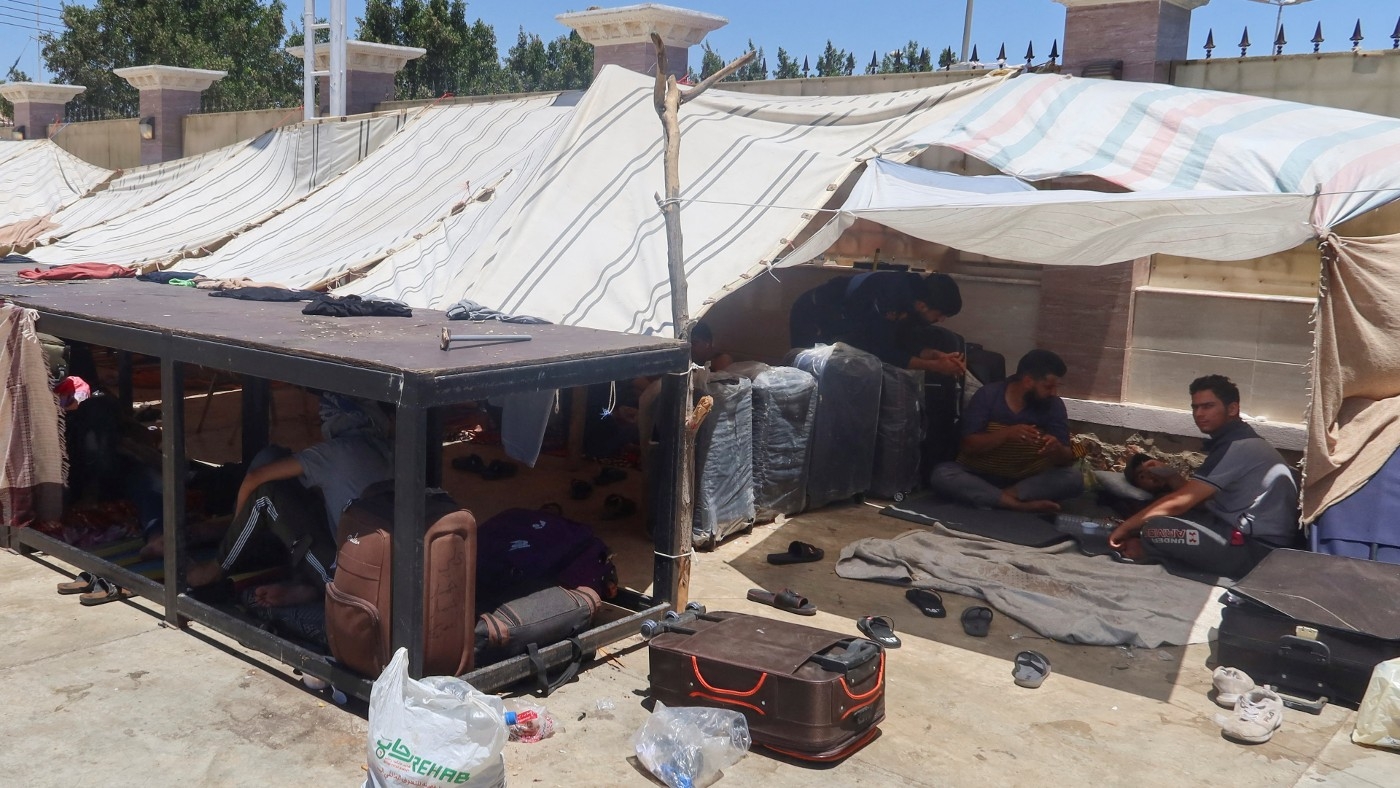
Mahmoud al-Shaibani was working at a restaurant in Khartoum when fighting broke out between the Sudanese army and the paramilitary Rapid Support Forces (RSF) on Saturday 15 April.
A refugee who fled war in his homeland, Yemen, al-Shaibani had settled into life in the Sudanese capital. “Everything was OK, then the war erupted,” he told Middle East Eye. “It was very aggressive.”
He and his family decided to leave the city, which has been at the centre of the raging fighting ever since it began.
They first went to Wad Madani, south of Khartoum, in the eastern-central part of Sudan.
“The situation was not that good there in terms of services,” Shaibani said. “So we moved to Port Sudan because the evacuation was supposed to be happening here.”
Now he is in Port Sudan, Shaibani and his family are struggling, like other refugees from Yemen and Syria, to return home.
“I see that foreigners are being evacuated through Port Sudan to Jeddah in Saudi Arabia, but we don’t know what the Saudi authorities have said about us,” he told MEE. “We don’t want to stay in Saudi Arabia. We want to go back to our country and we want to help the Sudanese government and the international organisations to get us there.”
Shaibani and his family are not alone. Syrians and Yemenis looking to flee conflict-ridden Sudan are sleeping on the floor of municipal buildings and on the streets of Port Sudan, with Saudi Arabia seemingly reluctant to welcome them into Jeddah, its port on the Red Sea.
As the humanitarian situation on the coast deteriorates, fierce fighting continues in Khartoum, its twin city Omdurman and in Darfur, in the west of the country. Sources in Sudan's capital told MEE that neither the RSF nor the Sudanese Armed Forces (SAF) had yet changed the balance of terror in the city, despite the formidable volume of artillery and aerial bombing unleashed by the army.
The United States, the United Kingdom, Germany and Norway are set to ask the United Nations council's president to convene an emergency meeting on the situation in Sudan.
State of emergency
Sudan’s major port and a place of relative calm, Port Sudan has become a crucial evacuation point for those seeking to leave the country.
Now, authorities in the city have declared a state of emergency. With just over 500,000 inhabitants, Port Sudan is struggling to accommodate the hundreds of thousands of people who have flocked there from other parts of conflict-ridden Sudan.
Some of these are internally displaced Sudanese, while others are looking to return to the foreign countries they come from, including Syria and Yemen, which have experienced their own civil wars and remain deeply unstable.
Having fled those wars, refugees from the two countries told MEE that they were now having to return home – and that Saudi Arabia, which is said to be anxious about Yemenis arriving in Jeddah, was making this difficult for them.
Riyadh is reportedly in discussions to run a direct cruise line from Port Sudan to Yemen’s Aden.
To deal with the deluge of new arrivals, authorities in Port Sudan have opened up the seaport corporation club, the police club, schools, and wedding halls in order to temporarily house refugees and internally displaced people.
Many are also sleeping in makeshift tents as they wait to find more permanent accommodation or a place on the ships leaving Port Sudan for Saudi Arabia’s Jeddah.
The city’s infrastructure is fragile, with roads, electricity, supplies of water, and internet all under threat. Only one internet provider is now working.
Services including housing and hotels are also buckling under the strain.
Local authorities told MEE they did not know how many people had come to Port Sudan and said that they were struggling to contain them. Sudanese initiatives to help people get food, water, housing, directions, and services have been put into action.
Cycles of war
Khalid Alhalaby, a Syrian refugee, is among thousands of people stranded at the police club in Port Sudan, one of the municipal buildings opened to host those who have flocked to the city, Sudan’s largest port.
“I came from Syria in 2014 and have been here in Sudan ever since,” he told MEE.
“I was working as a carpenter. The situation was very good and the Sudanese people were very nice to us. But we as Syrians have long experience with war and with the circumstances that are created by war, particularly displacement, splitting of families and other things,” he said.
Alhalaby said that he and his family were now keen to get back to Syria but that they didn’t know how to do that.
“We heard that we can be evacuated to Saudi Arabia and then back to Syria, but nothing has happened up until now,” he said. “The city here is very expensive and the situation is gradually deteriorating, so if we stay here for a long time we will run out of money.”
'But we as Syrians have long experience with war and with the circumstances that are created by war, particularly displacement'
- Khalid Alhalaby, Syrian refugee in Port Sudan
Almost all of Sudan’s international imports and exports are routed through Port Sudan, which sits on the Red Sea.
The port is still operating. Before the conflict between the army and the RSF erupted, the Red Sea coast of Sudan was already the site of international competition, with Russia looking to establish a naval base there, a plan vehemently opposed by the United States.
Now, international aid agencies including the International Red Cross and others from the United Nations have arrived in Port Sudan, alongside warships from the US, the United Kingdom, and France. The warships are being used to evacuate foreigners to Jeddah.
The arrival of aid workers and other foreign nationals, as well as the influx of refugees, has already pushed prices up in a Sudanese city known also for its beaches, affordability, and pleasant way of life.
This all looks set to change. Port Sudan has already become in practice the de facto administrative capital of Sudan. A number of ministers, including Finance Minister Gibril Ibrahim, are in the city.
Abdel Ahmed, an American of Sudanese origin, told MEE that his family had been visiting extended family in Sudan when war erupted while they were in Khartoum. “We suffered a lot to stay safe in Khartoum, then we moved to Port Sudan and finally we left to Jeddah in Saudi Arabia, where we are now,” he said.
“The process of evacuation is very random and chaotic. We stayed in Port Sudan for a long time without any clear idea about when and how we would leave,” Ahmed said. “We stayed without assistance at the Hilton hotel for many days.”
After arriving in Jeddah, Ahmed told MEE about the sea voyage, describing it as uncomfortable because he was onboard a US warship that had been docked in Sudanese territorial waters.
“Me, my wife. three children and other US citizens used a boat belonging to the Sudanese seaport corporation for about an hour and a half until we reached the warship,” he said.
“The waves were too high so the children were afraid inside the boat, but we were lucky and it took us half a day in the warship to reach Jeddah. We are staying in comfortable hotels in Jeddah and are waiting to go back to the United States,” Ahmed said.
For the Yemenis and Syrians still trapped in their thousands in Port Sudan, the situation is far less promising.
Middle East Eye propose une couverture et une analyse indépendantes et incomparables du Moyen-Orient, de l’Afrique du Nord et d’autres régions du monde. Pour en savoir plus sur la reprise de ce contenu et les frais qui s’appliquent, veuillez remplir ce formulaire [en anglais]. Pour en savoir plus sur MEE, cliquez ici [en anglais].



